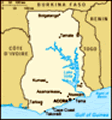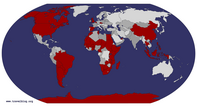Advertisement
Published: March 18th 2005
Ghana was the home of one of Africa's richest, gold dripping empires - which is why the Europeans came sniffing around this part of the West coast of Africa in the first place. The golden stool is used in the enthronement of the Ashanti kings. The Ashanti are matrilinial - it's the mother's clan that is important. The Golden Stool was also implicated in sparking off the Ashanti War of Independence of 1900 -1901. The British had demanded that they should be given the Golden Stool. When no one offered to give them the stool, the British tried to steal it. The war was led by a woman
Yaa Asantewaa, she died in exile in the Seychelles.
I've just spent some time in the Ashanti areas, and I have also visited the slave forts on the coast, built by the competing Europeans.
The ancient cultures of Ghana are still going strong despite centuries of European influence. One thing you cannot miss is the extent to which Ghanaians are religious - you see pious names on shop fronts! Often, one of the first questions you will be asked is about religion. The Ghanaians are also very

 Prempeh 11 Museum, Kumasi
Prempeh 11 Museum, Kumasi
First Official car used by Prempeh 11polite and friendly.
The rest of this blog is a continuation of the blog in diary format. It starts with me still being in
Tamale. FRIDAY 11th
I had to get up at 3.30am in order to catch the bus to
Kumasi. In fact I didn't sleep very well - I kept waking up. The reporting time for the bus was 4am, although it didn't leave till 5.30am. I got into Kumasi at about midday and booked into the Catering Rest House - a bit of a splurge - it cost about 25 pounds sterling a night. The rooms are big and clean. The rooms are modern bungalows with air con and satellite TV. I took it easy for the rest of the day, catching up on lost sleep.
Kumasi had been the capital of the
Ashanti Empire since 1695, and is Ghana's second biggest conurbation today. At the time of the Ashanti Empire, Kumasi had facilities and services equal to those of Europe at the time. The British ransacked and burnt Kumasi in 1874, but didn't finally control all of present day Ghana till 1901.
SATURDAY
12th
I spent most of the day feasting on Ashanti culture, which means I did the touristy things in Kumasi. I visited
Menhyia Palace, which has the palaces original furniture and life like wax models of Ashanti kings and Yaa Ashantawaa (the Queen mother), who led the revolt against the British and died in exile in the Seychelles. The present king now lives in another building behind the old palace. The guide told me that you can arrange an audience with the Ashanti king by requesting an audience with the administration block to the side of the museum.
After that I visited
Kejetia Market, the largest open air market in West Africa. Then I went to the
National Cultural Centre. There were various artisans at work, with their work for sale. At the cultural centre I went into Prempeh 11 Museum, which is full of historical artefacts. I then had some lunch in the restaurant in the grounds. At 2pm, in the heat of the day I returned to my room to cool off.
I didn't go out again till 5pm. In the evening a Ghanaian student studying politics and philosophy talked to
me at Baboo's Cafe. He suggested hitting a club - so we went clubbing. It rained heavily again during the evening. Not usual weather for this time of year.
When I returned to my room, I got a taxi because it was raining. The taxi driver tried to go back on his price and charge me more than he had agreed. When I got in the car he said it was 15000 Cedis. As he was driving the price mysteriously inflated to 25000. He wouldn't bargain. So, when he slowed down as he was approaching a junction, I opened the door and jumped out of the car. He followed me down the road, I was getting wet, but I was making a point. His price then dropped to 15000, so I got back in the car. When we got to the destination I gave him exactly 15000. When he looked a bit unhappy, I said, "that's what we agreed; that's why I got out of the car". He smiled and didn't argue.
SUNDAY 13th
I got up early and bought a ticket on the STV coach to the Cape Coast. The bus didn't
leave till 1pm - so I had some time to kill.
The bus journey was uneventful and got to the junction a few Km's outside of Cape Coast at 5pm. I got a taxi and booked into the Amkred Hotel - a mere 88000 Cedis (5 pounds). I walked around town and found somewhere to eat.
Later in the evening I went for a beer in a local bar or spot. There was a family group of people there, who had been at a funeral earlier. The bar was owned by one of the women in the funeral group. I was the centre of attention for the family's children and the women.
I was told that I was handsome far too many times by the women in the family. The woman who owned the spot was about the same age as me and had been an elected mayor of the town. She seemed a very capable and assertive woman. Despite all the compliments, I managed to leave at the end of the evening on my own!
MONDAY 14th
I went to the Cape Coast Castle as soon
as it opened. It was the headquarters for British colonial rule until the capital was moved to Accra in 1876. It was also a major slaving fort, one of a string of slaving forts littered along the coast of Ghana. I spent much of the morning in the fort and its museum.
The
Cape Coast Castle and its museum are a sobering place.Between 10 - 20 million people were sent across the Atlantic from forts like this all across West Africa. It should be remembered that most of the slaves died in the dungeons of the forts and the slaving ships. So, the size of the crimes of the Atlantic slave trade are huge. The pictures here don't show the total horror, you need to imagine the spaces full of people, with the stench of urine, feaces and death all around.
One of the pictures shows a punishment cell, where slaves and prisoners were locked up with no water and food until they starved to death. That particular cell had no natural light or ventilation.
The Europeans didn't capture the slaves themselves, that was done by African middlemen. The slave forts

 Execution Cell - Cape Coast Castle
Execution Cell - Cape Coast Castle
Slaves and prisoners were locked in this cell, with no food or water till they starved to death.were trading centres that traded many things including gold and manufactured goods from Europe.
The other side of this trade for me as a Brit are the big houses that were built in cities like Bristol and Liverpool. Many cities grew rich from the blood of millions.
TUESDAY 15
In the morning I went to the
Kakum National Park. The highlight is the canopy walkway. It is a series of 7 suspension bridges strung between the highest trees. This gives the visitor a view of the rain forest from the tree tops. After lunch I took it easy.
WEDS 16
I visited the castles at the pretty town of Elmina.
Elmina castle (St George's Castle) is the oldest fort on the coast of Ghana, built by the Portuguese in 1482. The original Portuguese Church in the middle of the fort was converted into a slave trading hall, when the Dutch took control. Again, I took it easy after lunch.
THURS 17
The 11am bus for Accra left at 1pm! When we finally left the driver greeted the passengers, and the passengers reciprocated in a

 Traditional African Shrine in honour of the ancestors at the Cape Coast Castle
Traditional African Shrine in honour of the ancestors at the Cape Coast Castle
At the site of the walled up tunnel from the slave dungeons to the Gate of No Return chorus. I said the Ghanaians were polite! He went on to apologise for the lateness of the bus in Twi, which I didn't understand, but the middle aged man sat next to me translated.
I got into Accra at 4.30pm and took a taxi to near the hotel I wanted - the taxi driver didn't seem to know the city very well; so I got him to drop me off on a main road near my destination. It took a very long time to travel a very short distance, I don't know if the traffic is always that slow. I suspect though it might have been due to the demonstration that there had been in Accra earlier in the day. It was a large demonstration from all accounts. The Government has dropped the subsidy on oil prices, which has led to a huge increase in petrol prices. This has had an effect on many other prices - taxi's and bus fares have risen by a third, and many other prices have risen as a result of the huge increase in the cost of transportation. Ghana is a poor country, so the increase in prices will hurt.

 Cape Coast Castle
Cape Coast Castle
The male dungeons which held 1000+ slavesI suspect though, that the political opposition would have done the same - they followed free market liberal policies when they were in power, ie they did what the World Bank and the IMF told them to!
I booked into a place that was a lot more expensive than I had in the Cape Coast. My Accra hotel is costing me $US50 a night. My Cape Coast Hotel was only 88000 Cedis (5 Pounds, or $US10). Then again the Cape Coast Hotel came with the added bonus of an army of little red ants in the bathroom. Maybe a natural cleaning service?
Advertisement
Tot: 0.492s; Tpl: 0.015s; cc: 37; qc: 139; dbt: 0.1985s; 1; m:domysql w:travelblog (10.17.0.13); sld: 1;
; mem: 1.6mb




























Rex Osae
non-member comment
Dir. Of Diversity Affairs
Wonderful pictures. I went back home five years ago to documentary on slave trade. As a result, I went to Cape coast, Elimina and other places to take to support my subject. Unfortunately, I have misplace my work. As a result, seeing your pictures certainly brings back memories including Kakum. I am grateful that you posting or shared these grate pictures because I am preparing another presentation and I can definitely use wonderful picture such as yours. Thanks Rex Osae